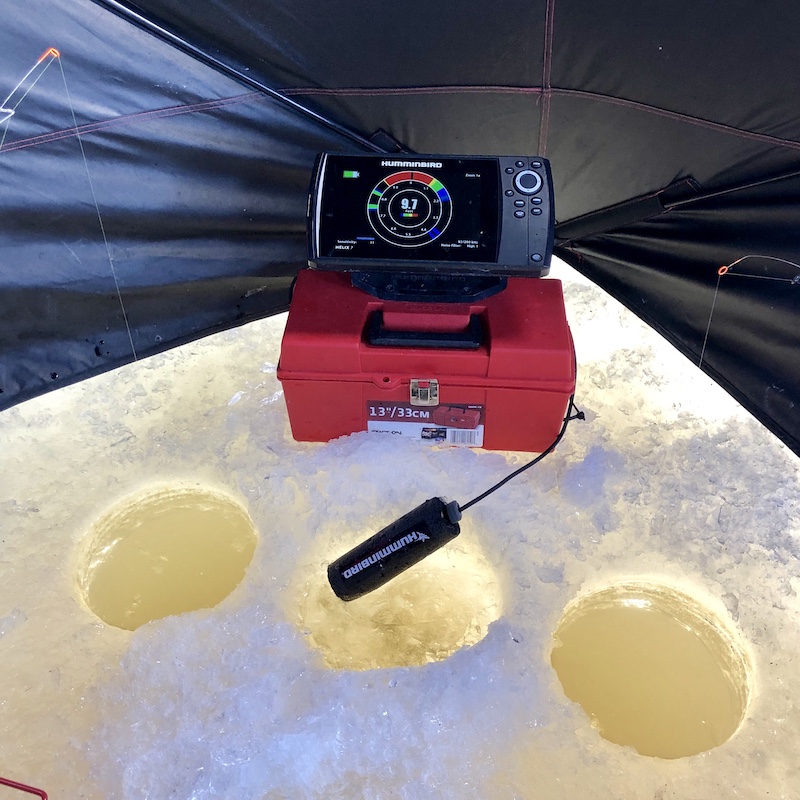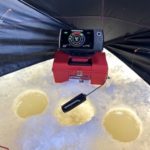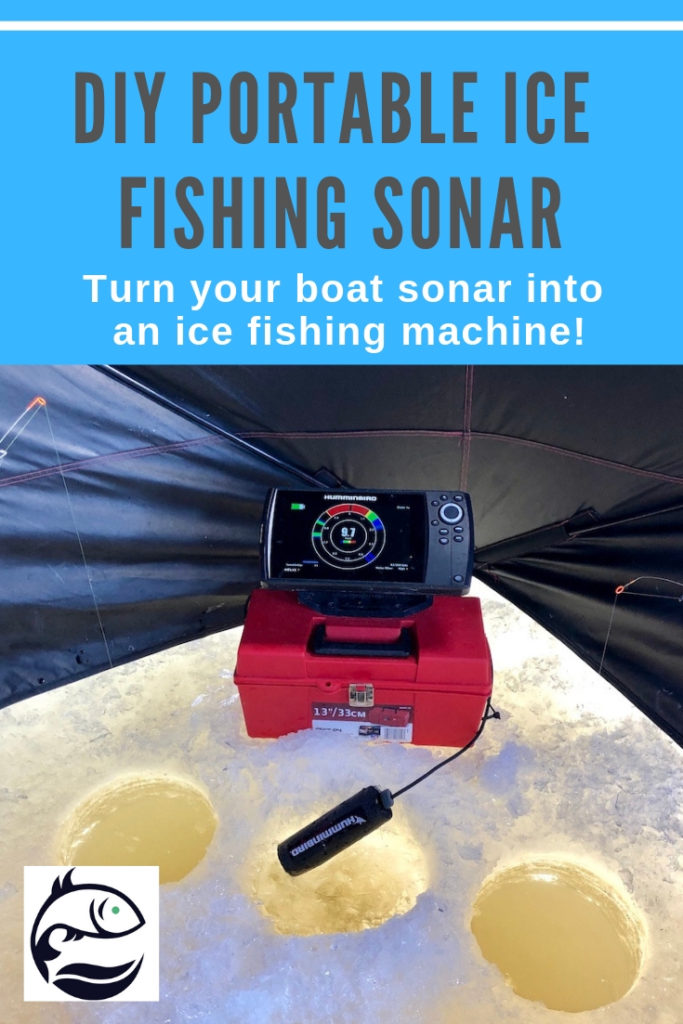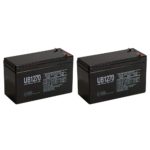I few years ago, I installed a new Humminbird Helix 7 on one of my old fishing boats. It’s a fantastic sonar unit, complete with GPS, mapping, Down Imaging, and Side Imaging.
It also has an Ice Fishing Mode.
I’m going to show you how I converted my summertime fish finder into a portable, full-featured ice fishing machine.

Why Convert A Boat Sonar For Ice Fishing?
Well, for me this story goes back quite a few years. Like 15 years or so.
I was just a young man, fishing on a VERY tight budget. I had splurged on my very first sonar unit for an old 14ft aluminum v-bottom fishing boat that has been in my family for years.
It was an Eagle Cuda 240, if I recall correctly. It had a grayscale LCD screen, rudimentary GPS capabilities, but it was great as a depth finder if nothing else.
Back then, I definitely couldn’t justify the price of a dedicated ice fishing flasher like a Vexilar or Marcum. But I was jealous of the guys I knew who fished with them.
So I did an experiment.
I grabbed a little 12v battery, mounted the boat transducer to a thin board, and hit the ice. Would it work? Was I an idiot? Well, I may have been an idiot, but……
To my surprise, by turning the chart speed all the way up, I could see my little ice fishing jig move up and down the screen! And I could see fish on it. And I caught some of those fish!
I ended up using that thing ice fishing for years, cobbled together though it was.
Enter the Helix 7
Over the years I’ve owned a number of sonar units, and various boats. But that old Cuda was the only sonar I had ever converted for ice fishing.
When I got the Helix 7, I quickly realized how awesome it could be on the ice.
- It actually has an Ice Fishing mode
- Detailed mapping and GPS capabilities let me use the same waypoints (structure, drop-offs, etc) in the winter that I find in the summer
- It has an available ice-ducer specially designed for ice fishing – so I can leave the transom mount transducer in place on the boat, and use the ice-ducer in the winter
- Tons of adjustable sonar options and settings, along with a couple of key screen modes let me dial it in for great performance on the ice
My DIY Portable Ice Fishing Sonar
This rig is a little bit funny looking, but it’s very convenient and it works great.

I ended up using a small, inexpensive plastic toolbox from the local hardware store as the base for my creation.
The tool box can fit a pair of 7AH (that’s amp-hours) 12 volt DC batteries, along with the ice-ducer. The Helix 7 is mounted on the lid of the tool box. Keep reading for more about the batteries and transducer.
When it’s time to fish, I open the lid, pull out the transducer, and fire it up.
Portable Sonar Conversion Video
I made a video a while back about this little project. I don’t have that boat anymore, but the Helix 7 is still going strong.
How Make Your Own DIY Portable Sonar
If you watched the video, you already saw how I did it, but I’ll go ahead and break it down for you. It’s really quite simple.
What You Need
- A Sonar Unit – I obviously used a Humminbird Helix 7, but you can use just about any unit for this project
- A transducer meant for ice-fishing
- A small/medium toolbox to hold the battery (or batteries) and to mount the sonar unit on
- One or more 12v DC batteries for power
The Sonar Unit
This project is well suited for any modern LCD/TFT-based sonar unit, so you can take advantage of the many display options, newest GPS, Mapping, and sonar technologies.
But it’s also a great way to put an older sonar to use, if you happen to have an extra one lying around.
I of course, used my trusty Helix 7 SI GPS. This exact model is no longer available , but here is a link to the latest comparable model.
There is also a complete ice-fishing package based around the Helix 7, if you decide not to go the DIY route.
The Transducer
In a pinch, you can use a boat-style transducer for ice fishing. As a matter of fact , that’s exactly what I did for years with my first DIY ice sonar rig. Unfortunately, there are some downsides to this:
- You need to build something to mount it to, in order to keep the transducer properly oriented towards the bottom
- You need to remove the transducer from the boat and reinstall it every year
- It will not be designed and optimized for ice fishing applications.
Luckily, many sonar units have specially designed ice fishing transducers. Humminbird makes one that is compatible with my unit, so I was in luck!
I ordered this one from Amazon. It includes a foam float, a very supple cable of very adequate length, and is capable of operating in 200khz, 83 khz, or combined 200/83 khz mode.
You will need to check to see if your manufacturer makes a compatible ice transducer for your unit.
The Batteries
The first time around I used an older 5ah battery I had lying around, but it wasn’t in great condition, and didn’t really last as long as I wanted.
To solve this, I bought two 7 amp-hour 12vDC batteries from amazon. They both fit inside the box with room to spare for the transducer.
About Battery Capacity
It’s a good to have some idea how much battery capacity you will need for a full day of ice fishing.
Most units will have a reference to the expected current draw in the owners manual, or online. However, this figure can sort of be treated as a rough guideline, as actual current draw can be affected by changing settings, turning on or off GPS, screen brightness level, and more.
You can get a more exact figure buy using a digital multimeter to calculate the actual current draw of the unit when running with the same settings you’ll be using on the ice.
Using that measurement (or estimate) you can decide how much battery to buy.
The battery capacity we most care about is a spec called Amp Hours. Theoretically, a 7 amp hour battery would be able to support a device that draws one amp continuously for 7 hours, or 7 amps for 1 hour. Or 3.5 amps for two hours, etc.
You can figure out your expected run time by dividing the current draw (in amps) by the amp-hour rating of the battery. Keep in mind that over time, the capacity of the batteries will degrade, leading to shorter run times.
On my own rig, I use two batteries, but I only have the sonar hooked up to one battery at a time.
When one battery runs low , I just swap the power cables to the other one. I bought a two-pack of 7 amp hour batteries from Amazon:
The 7ah capacity of each battery is great. I can generally get a full day of fishing (12 hours or more) out of one battery, but it’s always nice to have an extra fresh battery on hand.
Handy Tip: I found that the screen brightness is BY FAR the biggest drain on the battery, at least for my unit. By cranking the brightness all the way down to one or two, I can really extend the battery life. Works great inside my ice shelter, but if you are fishing outside on a sunny day you’ll need to crank the brightness back up.
Charging Your Batteries
If you buy a pre-packaged, all-in-one ice fishing sonar system, it will likely include a battery and a small, wall-wart style charger.
To charge, you just connect the charger to the unit and plug it into the wall.
When going the DIY route, you will need to use some type of DC charger. Luckily, these batteries are compatible with just about any 12VDC automotive-style charger on the market.
You may already have a battery charger you can use. If not, an inexpensive trickle/maintenance charger works great. I personally use a Black & Decker trickle charger similar to this one (a 6 amp model is also available). The time to charge your batteries will depend on the output of your charger.
I recommend choosing a model that goes into maintenance mode after charging is complete, to avoid overcharging if you forget to unplug it.
The NON-DIY Route
This style of sonar unit is becoming increasingly popular amongst ice-fishermen. In fact, there is now a dedicated Humminbird Helix ice-fishing package that includes a case, battery, ice transducer, all in one.
Here are a few popular ice fishing sonar packages:
Conclusion
Whether you are looking for a way to use your boat’s fish finder on the ice, or are looking to repurpose an extra sonar for ice fishing, building a simple DIY portable ‘kit’ like mine might be the way to go.
I hope this article was helpful, or at least gave you some good ideas.
Thanks for reading, now gear up and GO FISHING!





